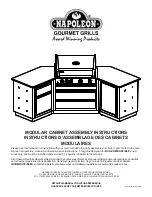
TROUBLESHOOTING
Let the grill cool before attempting to
check these tubes. Remove the grates to
access the flash tubes. They are located at
the rear inside the grill. Check the inside of
these tubes for obstructions. Use a
toothbrush or a doubled-up pipe cleaner to
feel for, and to remove any blockages. Look
for cotton-like objects (spider nests) or
mud-like obstructions (wasp’s nests). Clear
any obstructions found.
LOW OR INSUFFICIENT HEAT
Ensure that the grill has been pre-heated
for at least 10 minutes or that the hood
thermometer (if equipped with a hood)
reads around 350 degrees before cooking.
Do not line ANY portion for the grill with
aluminum foil. This will disrupt air flow and
cause the grill to burn too low OR too high.
Ensure that the grill is level. This will also
disrupt air flow and cause uneven cooking.
Make sure that the gas type being used (NG
or LP) is the gas type that the grill was set
for at the factory. The label with this
information can be found on the right rear
of the grill. If the grill gas type has been
converted (either at installation or at the
place of purchase) then check for the
following:
The Natural Gas (NG) grill has been
equipped with a gas regulator installed at
the rear. If this grill has been converted to
Liquid Propane (LP), then ensure that the
original NG regulator has been removed
from the rear of the grill before the LP hose
connection was added. Never use more
than one gas regulator to control gas flow.
This will substantially REDUCE grilling
efficiency.
If a low heat condition still persists, check
that the gas line (for NG applications) is of
adequate size for the length of run or the
equipment being used. The minimum size is
1/2"(I.D.), but the larger 3/4"(I.D.) size is
recommended for optimum performance.
See section entitled ‘NATURAL GAS’ under
the ‘GAS CONNECTIONS’ portion of this
manual.
If the gas used is Liquid Propane (LP), check
that the gas hose is not being ‘crimped’ and
is connected to the tank properly. The hose
and regulator assembly MUST be the hose
that has been supplied with your LazyMan
grill.
Low or insufficient heat can also be caused
by burner obstructions. Follow the burner
removal instructions found in the section
entitled ‘CLEANING THE BURNERS’. With
the burners out of the grill, look inside each
burner for obstructions that may interrupt
gas flow. Follow the remainder of that
section.
Windy conditions can greatly interrupt air
flow and cause insufficient heat conditions.
If heavy winds are prevailing and are
coming from the SIDES or FRONT, and if
your grill is freestanding, you should move
the grill to a more suitable location. If the
location of your grill is permanent (island
applications) then try grilling more with the
hood closed if equipped.
If the winds are strong and coming from the
REAR, DO NOT CLOSE THE HOOD. In this
case, grill only with the hood OPEN.
24
Summary of Contents for LM210-28
Page 1: ...LazyMan Gourmet Grills USE AND CARE GUIDE LM210 28 LM210 40 SERIES...
Page 23: ...19...
Page 31: ...27...
Page 32: ...28...







































